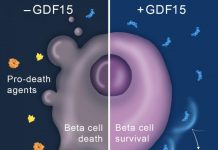August 2004 - University of Toronto researchers have identified individual cells in the adult mouse pancreas capable of generating insulin-producing beta cells.
Their research, published Aug. 22 in the online edition of Nature Biotechnology, offers hope for the millions of diabetics worldwide who take insulin injections to compensate for defective pancreatic islets. Healthy islets, made up largely of beta cells, release insulin to help regulate the body's blood sugar levels.
"People have been intensely searching for pancreatic stem cells for a while now, and so our discovery of precursor cells within the adult pancreas that are capable of making new pancreatic cells is very exciting," says Simon Smukler, a PhD candidate in U of T's Department of Medical Genetics and Microbiology, who was one of the lead researchers. He conducted the study along with U of T MD/PhD candidate Raewyn Seaberg and their supervisor, Professor Derek van der Kooy.
The scientists are now hoping to extend their research to prove that these precursor cells are truly stem cells. True stem cells must exhibit two properties: the ability to renew themselves over the entire life of the organism and some ability for the parent cell to generate varied cell types � for example islet cells and exocrine cells. Pancreatic stem cells could provide a plentiful supply of beta cells for transplant treatments.
A finding Smukler considers equally exciting is their discovery that these pancreatic cells generated both beta cells and neurons, cells associated with the workings of the brain and the nervous system.
Continue Reading Below ↓↓↓
"The existing dogma regarding how development occurs states that fairly early in development, there is a distinction made between a group of cells destined to make the brain and another group destined to make the pancreas," he says. "The idea that a single cell within the pancreas could make both beta cells and neurons is intriguing."
U of T has a proud history of both diabetes and stem-cell research. Frederick Banting and Charles Best discovered insulin here in the 1920s, while years later, Drs. Ernest McCulloch and James Till first described the stem-cell concept.
This study was supported by the Stem Cell Network and the Canadian Institutes for Health Research. Zeenat Ashgar and Michael Wheeler from the U of T's Department of Physiology, Grigori Enikolopov of New York's Cold Spring Harbor Laboratory and Stem Cell Network members Timothy Kieffer of the University of British Columbia and Gregory Korbutt of the University of Alberta also contributed to the research.
"This remarkable discovery is a case study in cross-Canada cooperation," says Dr. Ron Worton, Scientific Director of the Stem Cell Network. "The research offers considerable new hope for people living with diabetes."
Source: University of Toronto









